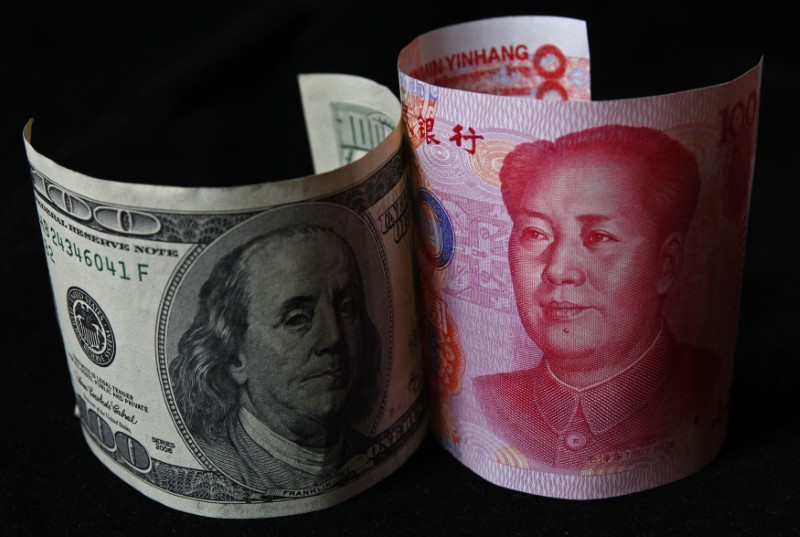 © Reuters. Yuan Strength Leaves Market Guessing at China’s Line in Sand
© Reuters. Yuan Strength Leaves Market Guessing at China’s Line in Sand(Bloomberg) — The strongest yuan in more than two years is prompting speculation about possible steps to cool its gains.
The currency rose to as high as 6.4138 per greenback on Monday, its strongest level since December 2015, before easing to 6.4440 as of 9:39 a.m. Tuesday. When the yuan rallied beyond 6.5 in September, policy makers made it easier to bet against the currency.
The central bank’s decision to change the way the yuan’s daily reference rate is set, as reported by Bloomberg News last week, was seen by some analysts as a way of slowing the pace of the currency’s gains. While the yuan initially slumped on the news, it’s since rallied 1.3 percent in one of Asia’s biggest advances. For Mizuho Securities Asia Ltd., the next level to watch is 6.4.
If the yuan rises beyond 6.4 per dollar, the People’s Bank of China may intervene by “relaxing capital controls on outflows, and allowing people to hold and exchange foreign currencies and assets more freely,” said Shen Jianguang, chief Asia economist at Mizuho Securities in Hong Kong.
Others are focused on how the yuan is performing against a basket of its trading partners’ exchange rates, given the dollar’s persistent weakness. An index tracking the yuan’s changes against 24 currencies has been in a narrow range of 94.2 to 95.4 since the start of September. It was last at 94.97.
Khoon Goh, head of Asia research at Australia & New Zealand Banking Group Ltd., said gains above 95 increase the chance of a signal to slow appreciation. For example, the PBOC may set the fixing at a much weaker level or reintroduce the counter-cyclical factor with a bias to the weaker side, he said.
For Ding Shuang, chief economist for Greater China and North Asia at Standard Chartered (LON:) Plc in Hong Kong, the PBOC may step in at 95.5.
“Policy reactions may include outright interventions right before close, or a relaxation of outflow control measures to release the yuan appreciation pressure,” Ding said. “The government will likely gradually expand the range each year, paving the way for a lightly managed float in two to three years.”
Iris Pang, an economist at ING Groep (AS:) NV in Hong Kong, said there’s less incentive to intervene now that China’s exports aren’t as sensitive to yuan appreciation given the growing share of value-added products.
“I don’t think the PBOC has any next line of defense” unless a very rapid gain is seen, Pang said.
(Updates moves in second, third and fifth paragraphs.)
To contact Bloomberg News staff for this story: Xiaoqing Pi in Beijing at [email protected].
To contact the editors responsible for this story: Richard Frost at [email protected], Will Davies
Fusion Media or anyone involved with Fusion Media will not accept any liability for loss or damage as a result of reliance on the information including data, quotes, charts and buy/sell signals contained within this website. Please be fully informed regarding the risks and costs associated with trading the financial markets, it is one of the riskiest investment forms possible.
Source: Investing.com





























